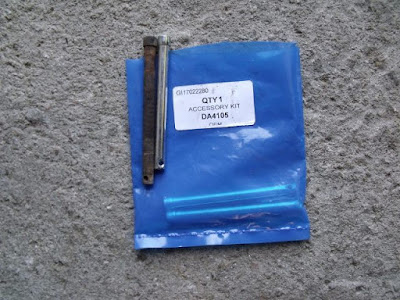This is the same wheel and tyre combination we've had fitted before, but when fitted to Daphne we didn't have the wheel spacers that Elly has got. Opinions vary on the usefulness of these but we decided to keep them and try them out. They're supposed to give a better turning circle, which for a Defender can't ever be a Bad Thing since they have the directional manoeuvrability of an ocean liner.
Anyway, the spacers are 30mm wide, which gives us the problem you can see here. The standard Defender wheel arch extension isn't deep enough.
The solution most people go for is something like this:
Searching around for a DIY solution it occurred to us that the design in the picture at left was, basically, the original "eyebrow" with a bit added to the back to make it stick out more. What if I added a bit, but to the front edge?
We thought about various bits of flexible or mouldable material like rubber, plastic, fibreglass or thin aluminium. None of these had a reliable means of fixing to the eyebrows at the right angle - there isn't much of a "lip" to hold a clip so whatever we used would have to be screwed and/or glued in place.
With a bit of lateral thinking, we came up with this:
This is from Screwfix and is sold as industrial door seal. The retainer is aluminium and the bit that does the sealing is a rubber-like strip. The whole thing is semi-flexible and you get 2 pieces each 1250mm long for £16. This is enough for 2 wheel arches. The only problem is they're straight and need to be curved. This requires patience and a bit of thought but, with care, you can get a pretty effective result:
1. Assemble the strip and the retainer, drill some extra mounting holes about 4mm diameter. Having marked a datum point on the arch and the seal, work from one end to the other, gently forming a bend in the aluminium. I used Bulldog (paper) clamps and spring clips to hold it in place as I went along. I did the first one but bent the aluminium first. It was easy but then trying to slide the black "rubber" bit into the now distorted channel was, shall we say, a bit of a test.
2. Eventually you'll end up with something like this.
4. Mark the correct length then remove the new extension. I intended to cut the ends to follow the line of the original arch. It looks a bit neater and more "finished". Don't cut it yet, though, in case you need to adjust the position of anything as you make the final fix. This is just to put the holes for the end fixing screws in the right place as it's easier to do on the bench:
 |
| This is the rear end of the driver's side |
5. With everything secured as best you can, drill through the holes for the fixing screws. Choose your drill size very carefully for the size of screw you'll be using. I drilled 1mm undersize for the stainless steel screws I was using, and tested to make sure it wasn't loose or so tight I'd crack the eyebrow lip - it isn't very thick. Do one at a time and put the screw in before drilling the next one. The lip on the eyebrow is also very narrow so accuracy is needed here. Remember to make sure the top edges butt against each other as the tension in the eyebrow works against this. You may have to jack the bodywork up to give room to get the drill under the arch. The alternative is to remove the wheel, of course, but this makes for a much longer job. It was cold, so I didn't do that. Lazy!
6. Once all the fixings are in place, take it off again and trim the ends to the profile you've chosen:
7. Do a final test fit and once you're happy, apply some of this stuff - or something similar - to the back of the aluminium strip:
I did a trial the night before the final fitting just to check it would stick and it took quite a pull to get the test piece off, so it'll do for what we need it to do.
8. Then fit it all together again, tightening the screws in order. It'll help to have someone support the new piece as you work along the edge otherwise the glue will get onto everything you don't want it to.
 |
| I'll probably trim the forward edge to a more streamlined shape, but at the moment it seems about right. |
..and this is what you end up with. Not really heavy-duty but good enough for us. It makes Elly road-legal now and for £32 and a couple of hours work, not a bad solution. Not only that, but the bodywork now stays cleaner since a lot of the muck that the unprotected tyres threw up is caught and prevented from hitting the bodywork. If it doesn't stand the test of desert travel we haven't lost much and we'll probably do what everyone else does and shell out for those ugly, pumped up things. Or take the spacers off....






























